Swiss Meringue Mini Pavlovas with Blood Orange Curd
Get ready to fall in love with your new favorite dessert: mini pavlovas with blood orange curd! Mini pavlovas are such a fun dessert to brighten up any table! They can be filled with your favorite fresh fruits and curd, and topped with whipped cream to balance it all out! Here, we’re using a fresh homemade tangy blood orange curd while they’re still in season!
Pavlovas originated in Australia or New Zealand and are one of my all time favorite desserts! I can’t believe that I’ve only discovered them last year! Although, since then, I haven’t been able to stop making them for my family. When perfectly made, they are crisp and smooth on the outside and pillowy and marshmallowy on the inside!
A pavlova is made from whipped egg whites + sugar. After it’s whipped to glossy, stiff peaks, it’s transferred to a baking pan, shaped into a mounded tutu dress, and baked in the oven with a low temperature for a long period of time. Importantly, the pavlova must also rest and cool very gradually inside the turned off oven to prevent it from collapsing or cracking. When the pavlova is completely cool, we can fill and top it with our fave fresh fruits and whipped cream!
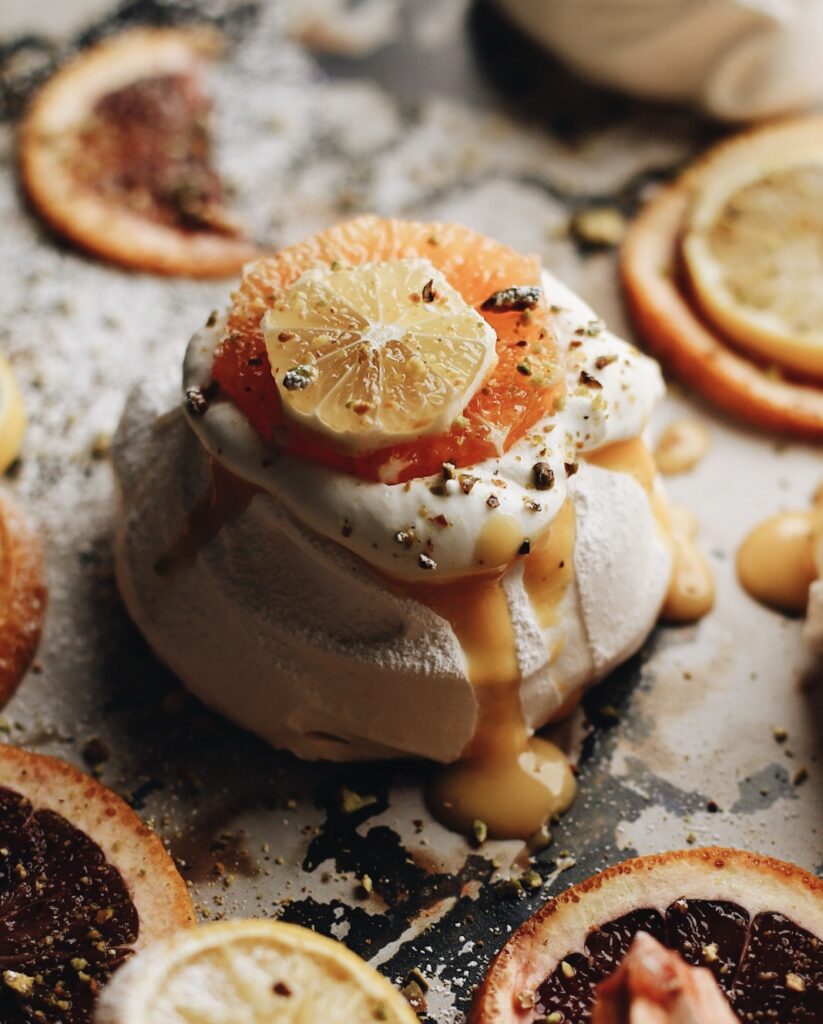
Technique for Perfect Meringue
There are many different ways to whip up a meringue! Italian, French, Swiss, and probably more! But my all time favorite method for these blood orange curd mini pavlovas is the Swiss meringue. With this method, we start out with a completely clean, grease free mixing bowl ( I always use the stainless steel stand mixer bowl). Egg whites and granulated sugar are combined in the bowl, then placed over a double boiler over low-medium heat. We constantly mix or whisk the egg white mixture, until all the sugar has dissolved and it reaches 170 degrees F. At this point, this Swiss meringue can be used to top tarts, pies, or used as the base for Swiss meringue buttercream! YUM!
But since we’re making mini pavlovas, let’s move on!
We’re going to place the bowl onto our stand mixer and whisk on high for several minutes until we get glossy stiff peaks!
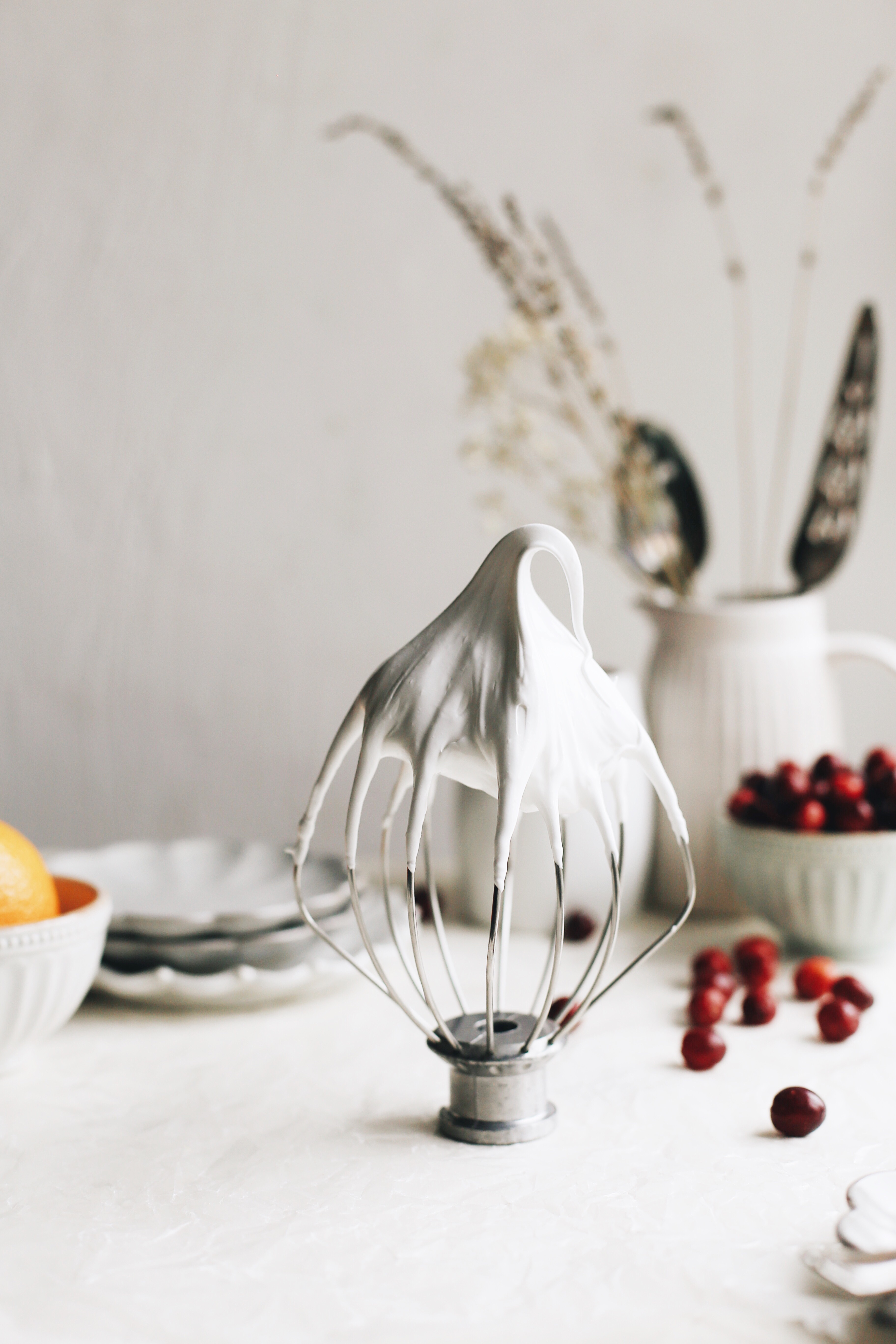
Lastly, we pour in the bit of vanilla extract, cornstarch, and lemon juice, give it a quick whisk until combined, and we’re done!
The first fun part here is shaping our mini pavlovas! I’ve also piped mini pavs before as well but the plop n’ shape is actually my favorite method! Not only because I can spare the piping bag but I find that it offers a much more pillowy center!
With a large spoon, I spoon about 1 1/2 cups worth of meringue onto my parchment lined baking pan, making sure that it is a relatively tall mound. Then, we can start to shape the outside with a small offset spatula or back of a spoon. I like to round off my pavlovas and then create a 1/2 inch deep crater/indent on the top for fillings to go into later!
After all the meringue has been plop n’ shaped, we stick the whole thing in the oven, close the door, and immediately lower the temperature! Pavlovas cook in a low heat for a longer amount of time, then, they also rest for a longer amount of time. All this precise science ensures that you come out with beautifully smooth, white, usually crack-free, mini pavlovas with the perfect ratio of crispy exterior and pillowy interior!
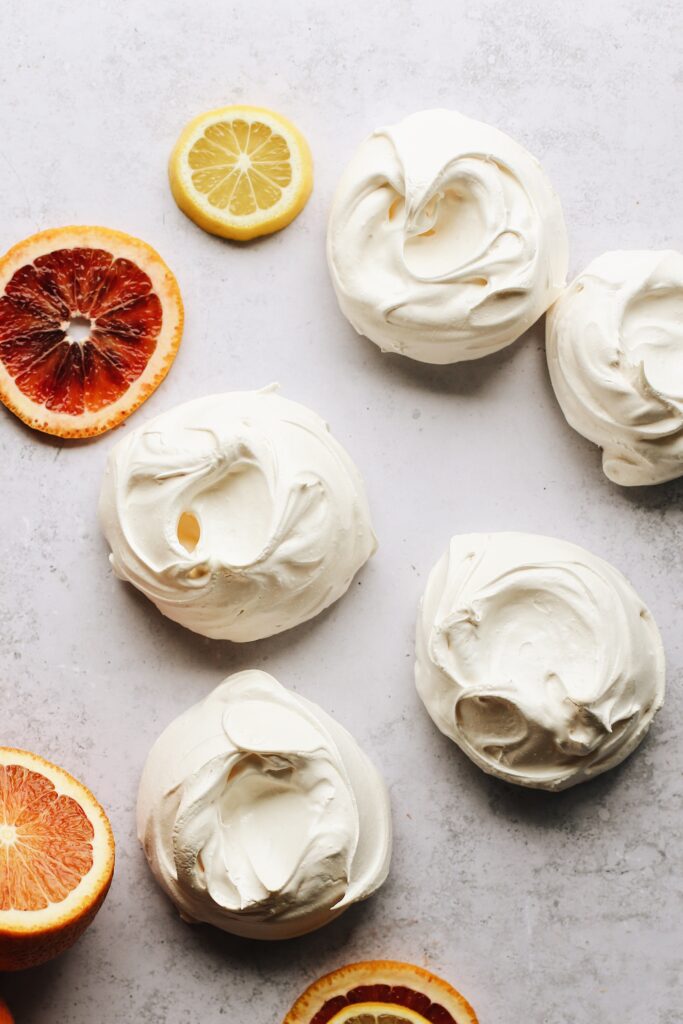
Blood Orange Curd
One of my favorite curds ever and I can’t even tell you how many times I’ve made it since blood orange season this year! And it’s SOOO easy to make! No tempering egg yolks or anything complicated! And it is by far my favorite curd for topping mini pavlovas!
We start by combining fresh blood orange juice, lemon juice (for extra tang and complex flavor profile), sugar, yolks, and zest to a saucepan. Give it a quick whisk to combine, then we set it over a low heat and stir constantly to make sure we don’t scorch or curdle the mixture. We cook it like this for several minutes (up to about 10 minutes), until it coats the back of a spoon and is 170 degrees F. Remove it from the heat and quickly stir in the butter until it’s melted. And you’ve made blood orange curd! Trust me, it’s so crazy amazing that you’ll be tempted to eat the whole thing by the spoonful!
After we strain it through a fine mesh strainer, we let the curd cool completely in a clean glass jar or bowl and then chill it in the refrigerator. It will thicken slightly once completely cooled.
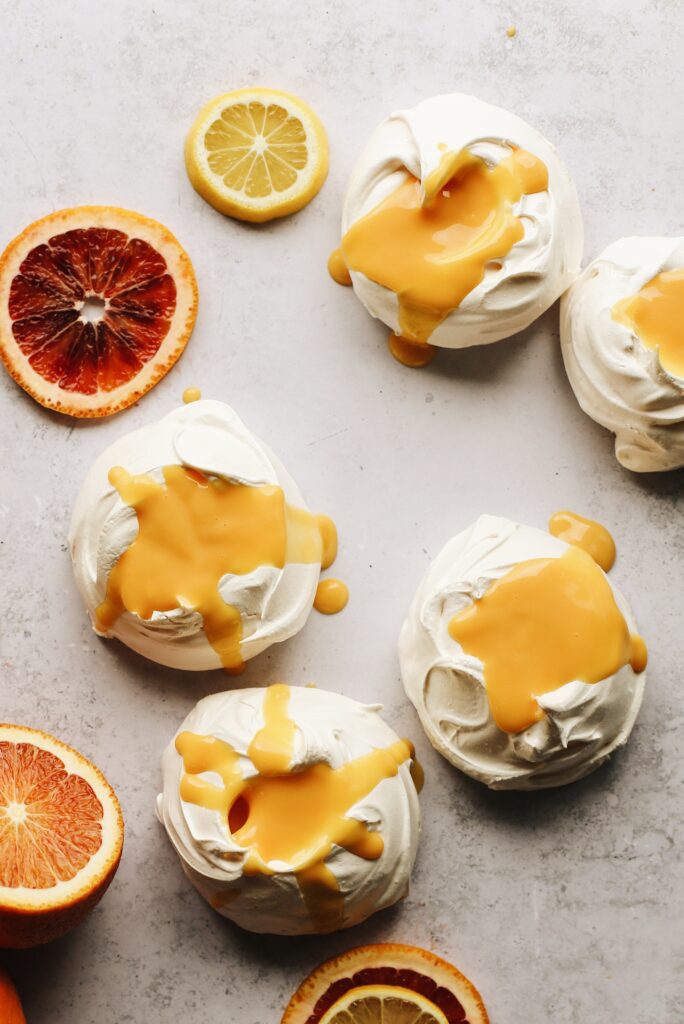
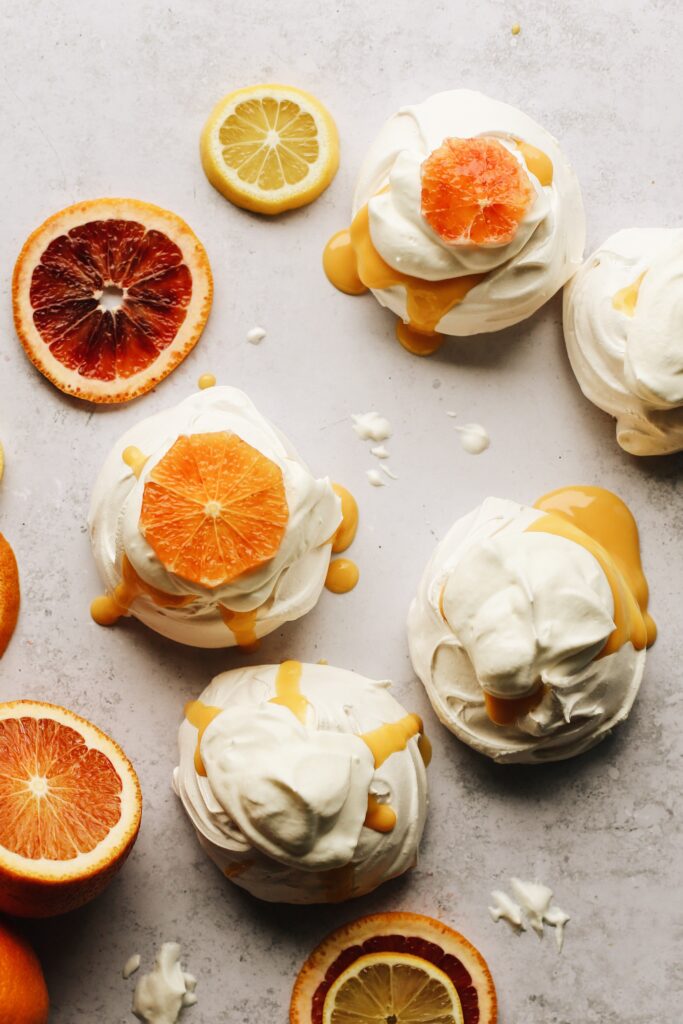
Tips for the Best Mini Pavlovas
- There are quite a few steps to these mini pavlovas, but if you break them apart and prepare well, it actually comes together very easily and smoothly! For example, I typically prepare the curd up to 1-2 weeks ahead of time and store it in the refrigerator. The pavlovas can also be made the night before and kept resting overnight in the oven!
- Meringue might seem tricky to a beginner but it’s quite easy! My number 1 tip is to make sure that your bowl and whisk are completely clean, dry, and grease free! This is because any amount of grease or fat will not allow egg whites to whisk up. This brings us to our next tip:
- When separating eggs, they’re easier to separate when cold. Make sure you don’t let any yolk mix in with the whites because of tip #2!
- With each step, especially for making the Swiss Meringue, it is important to have all the ingredients ready and measured out before you get started. Once you get going, you don’t want to have to stop.
Happy baking! Don’t forget to rate this recipe and tag me on Instagram if you try it out!
You might want to pipe the meringue out like in these heart shaped meringues or use this curd with these linzer cookies!
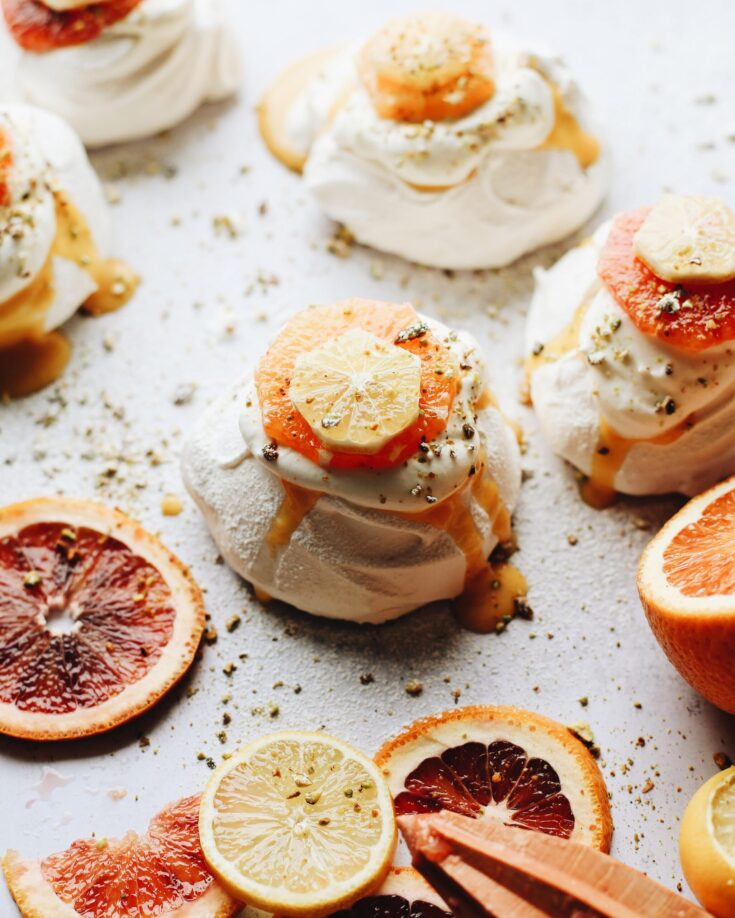
Mini Pavlovas with Blood Orange Curd
Beautiful mini pavlovas filled with blood orange curd with a perfectly crispy exterior and fluffy interior! Perfect Springtime dessert!
Ingredients
Swiss Meringue Mini Pavlovas
- 5 egg whites (165g)
- 1 1/2 c + 2 tbsp granulated sugar (300g)
- 1 tsp pure vanilla extract
- 1 tbsp cornstarch
- 2 tsp fresh lemon juice
Blood Orange Curd
- 1/2 c fresh blood orange juice
- 1/4 c fresh lemon juice
- 1/3 c granulated sugar
- 5 egg yolks (leftover from pavlova ingredients)
- zest from blood oranges and lemons
- 4 tbsp unsalted butter cubed
Whipped Cream
- 3/4 c heavy whipping cream very cold
- 2 tbsp granulated sugar
- 1/4 tsp kosher salt
- 1 tsp pure vanilla extract
Instructions
Swiss Meringue for Pavlovas
- Preheat oven to 350 degrees F with the rack in the middle of the oven and line a large baking sheet with parchment paper. Bring a small-medium saucepan with about 1-2 inches of water to a simmer.
- In the clean and dry bowl of stand mixer (or other heat safe bowl), combine egg whites and sugar. Place bowl on top of small saucepan of steaming simmering water (over low heat) to create a double boiler, without letting bottom of bowl touch the water.
- Constantly mix egg whites and sugar as the mixture gradually heats up and all the sugar melts. Cook for about 5-7 minutes, until all the sugar has dissolved and mixture reaches 170 degrees F on an instant read thermometer.
- Remove from heat and with a clean and dry whisk attachment on stand mixer, whisk on high until stiff peaks form. With the mixer off, pour in vanilla, cornstarch, and lemon juice. Whisk on high to combine for 20 seconds.
- With a spoon, scoop out desired amount of meringue (depending on how big or small you want your pavlovas) onto the parchment paper, equally spacing lumps of meringue. With a small offset spatula or back of a spoon, shape around each meringue to tidy them up. With the back of a spoon, create a small well or crater on the top of each meringue.
- Place entire baking pan into the oven. With oven door closed, immediately lower oven temperature to 220 degrees F. Bake for 2 hours. Without opening the oven door at any point, turn oven heat off and let pavlovas rest and cool in oven undisturbed for 2 hours.
Make Blood Orange Curd
- In a small or medium saucepan, combine all the curd ingredients EXCEPT butter and whisk well to combine. Place saucepan over low heat and mix constantly with a rubber spatula.
- Curd will slowly start to thicken after a few minutes. Keep the heat low so the yolks don’t curdle! Continue stirring until curd can coat the back of a spoon or spatula and reaches 170 degrees F. Remove from heat and immediately add cubes of butter. Stir well until all butter has melted. Strain through a fine mesh strainer, pushing it through with the rubber spatula. Pour into a clean glass jar or bowl and cool completely, then chill in the refrigerator. Curd will thicken the longer you chill it.
Make the Whipped Cream
- Add all whipped cream ingredients into the bowl of a stand mixer. Whisk on low-medium for a minute to dissolve sugar. Then, whisk on high for a few minutes until the cream is almost at stiff peaks. Keep chilled in refrigerator until ready to use.
Assemble the Pavlovas!
- When ready to enjoy, spoon about a tablespoon or more chilled curd into each pavlova. Top with a spoonful of whipped cream and whatever fresh fruit you desire! I sprinkled mine with crushed pistachios and then dusted with powdered sugar!
Notes
- Prepare ahead: Pavlovas can be prepared overnight, and left to cool in the oven overnight to be topped the next day.
- Prepare ahead: Curd can be made and kept in the refrigerator for up to 2 weeks in advance.
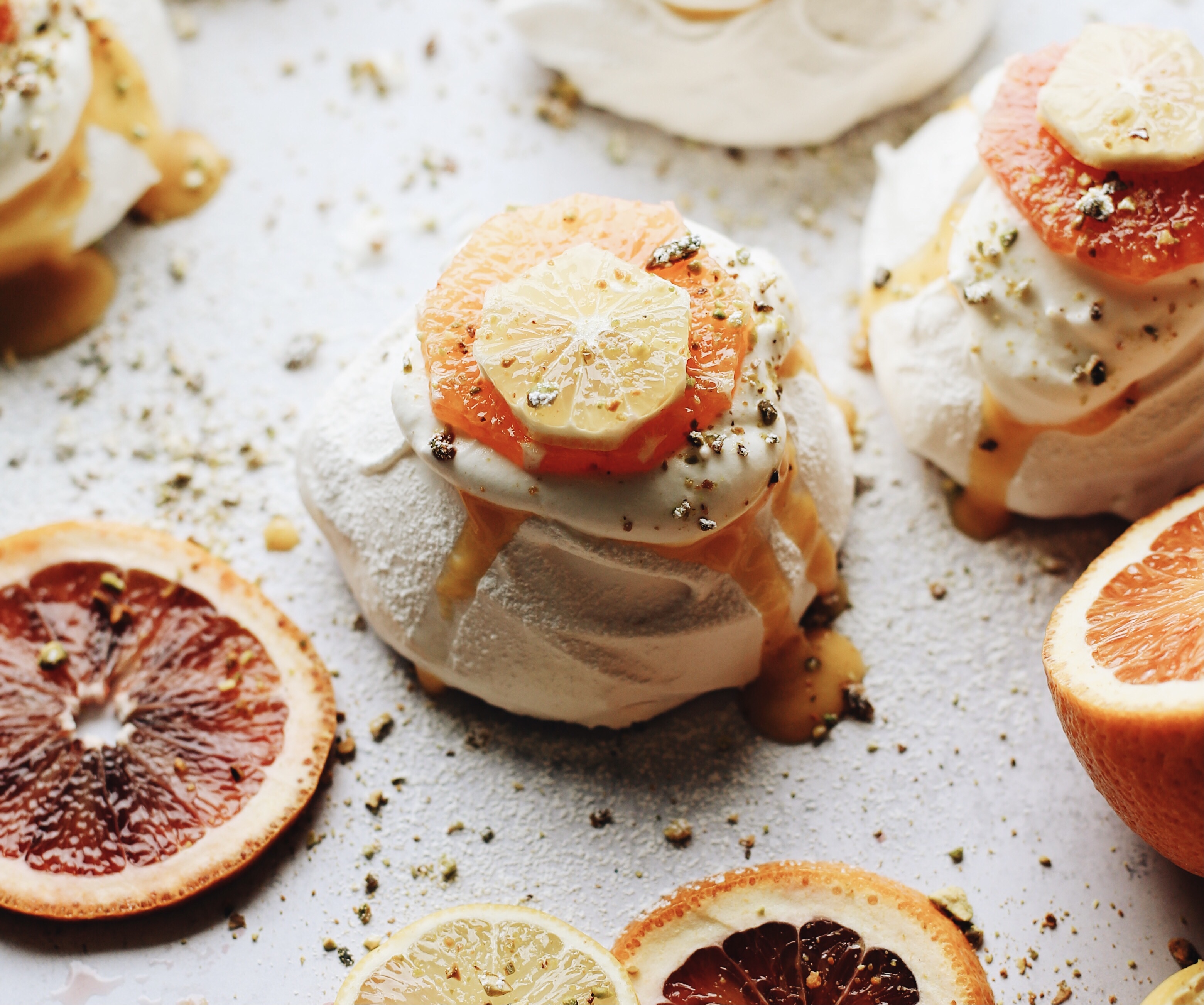




 Based on 2 Review(s)
Based on 2 Review(s)
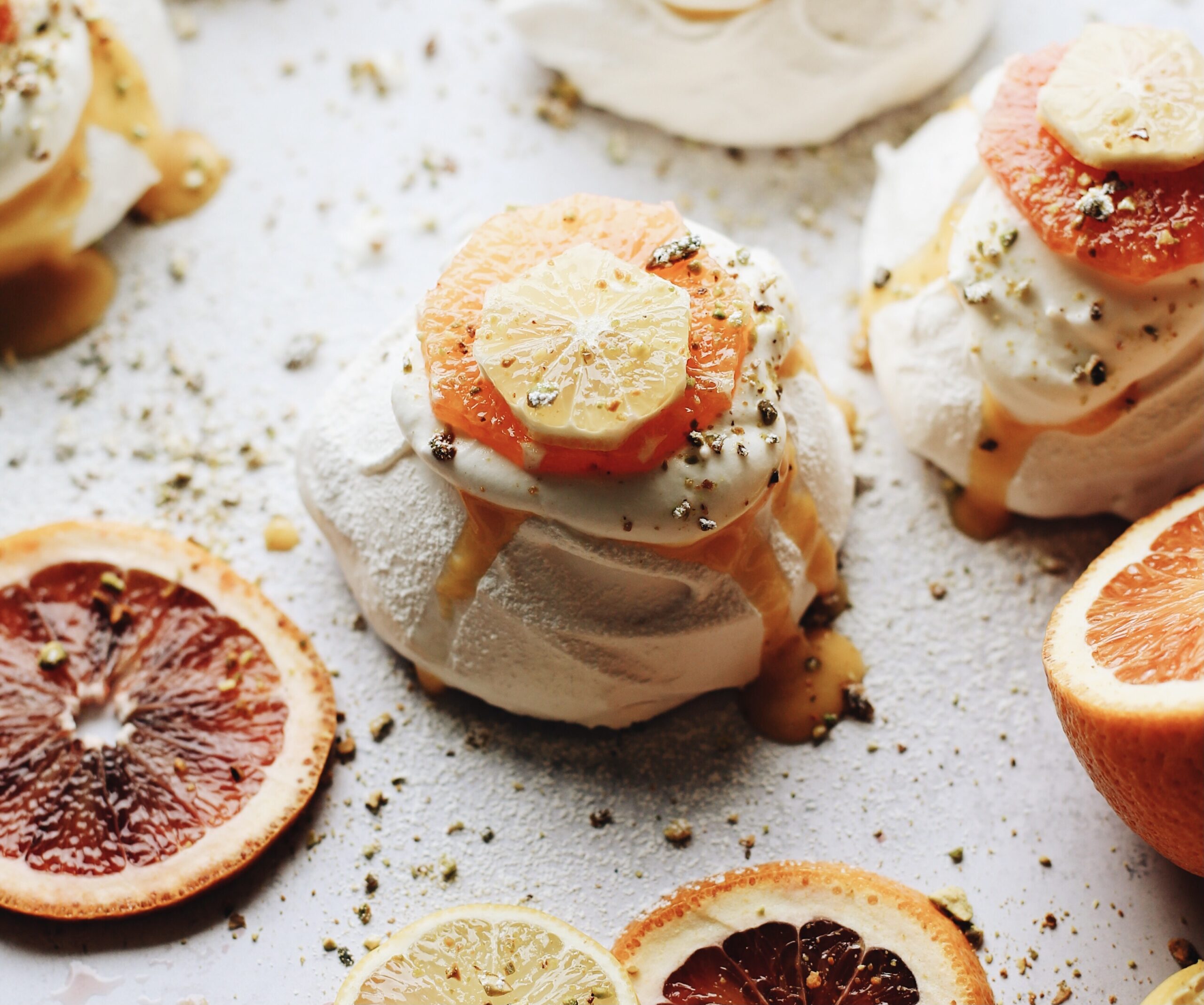
My husband has a corn/corn product sensitivity. Is there a suitable substitute for the virus starch? Thanks
What the heck did auto-correct do? Virus starch??? Corn starch
Haha virus starch! Anyway, I haven’t ever tried it, but potato starch should do the job!
Are the mini pavlovas still soft and chewy in the middle? And for the egg whites and sugar, do you have them in a bowl within a bowl over the heat? Or in just one bowl over heat?